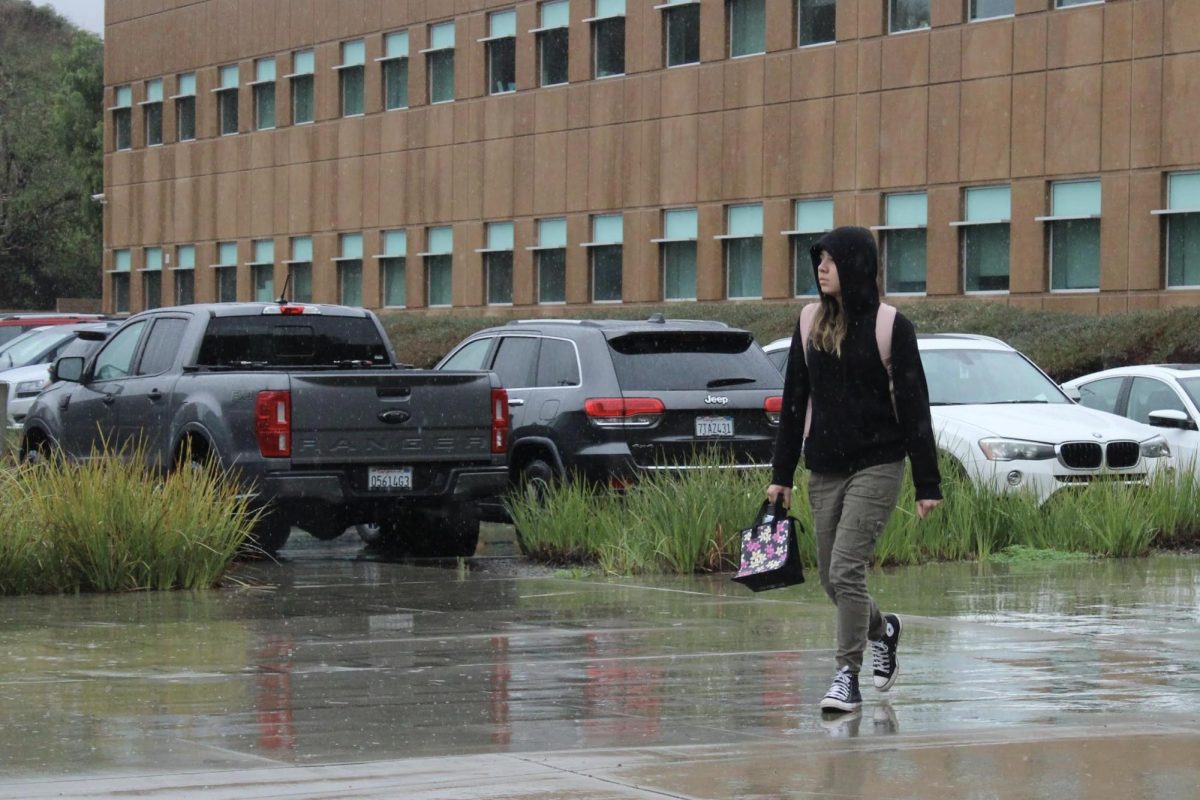Sodden socks, soaked backpacks, and drenched jeans were the norm for students on the BOHS campus this week as California experienced unprecedented levels of rainfall.
By early Monday morning on Feb. 5, Brea was the wettest city in Orange County with 1.42 inches of recorded rain. By Tuesday, that total had increased to 6.26 inches, the most in north OC.
Governor Gavin Newsom issued a state of emergency proclamation in eight counties across Southern California on Feb. 4. The National Weather Service declared that several counties — including Orange — experienced a Category 5 “atmospheric river” — the most extreme on a five-level scale.
This deluge is the most rain that the state has seen in two decades.
Andrea Ramos, AP Environmental Science teacher, explained that the “heavy rainfall this week is due to a pineapple express” — the nickname for atmospheric rivers in areas near the Pacific Ocean and Hawaii. Atmospheric rivers, which transport water vapor through the atmosphere, can carry volumes of vapor equivalent to the flow of the Mississippi River.
Ramos explained that El Niño — a naturally occurring climate phenomenon that heaves strong winter rains in California due to the rise of warm water — is responsible for creating the current atmospheric river in California. Because of the rise in sea temperatures — up to five degrees above average — “the amount of rain we are receiving this week is unusually high,” Ramos said.
Sahaana Mehta, junior, witnessed her backyard flooding on Sunday evening. “I was having fun at first. It felt like a pool was developing in my backyard.” But then it “began to get scary” when the grass, patio furniture, and eventually the doorsteps became submerged in the rapidly rising water.
On Monday, while California State University, Fullerton (CSUF) — located 3.4 miles from BOHS — and other Southern California colleges and universities moved to online instruction for the day, most elementary and secondary districts in OC remained open.
On BOHS’s campus, students huddled under umbrellas and awnings and sought refuge in open classrooms. In the open-air quad area, Wildcats navigated puddles, muddy grass, and water cascading down staircases. Indoors, the squeaks of shoes down hallways and the patter of rain against the fogged-up windows served as reminders of the unrelenting downpour.
On Tuesday, student and staff phones pinged with emergency alerts, warning of a flash flood that could potentially be a “dangerous and life-threatening situation.”
The rain also interfered with many students’ routines.
Football and soccer suspended off-season outdoor activities for the week.
Jayden Lee, junior, usually rides his bike to campus, but he was late to class on Monday because he had to find a ride.
Some students, like Sofia Rodriguez, sophomore, chose not to attend at all to avoid the potentially hazardous commute. “My mom was really scared of driving in this weather so she made me stay home,” Rodriguez said.
Daniella Olumese, senior, and her brother were victims of the treacherous road conditions when her car hydroplaned across the slick pavement and crashed into the curb on her drive home from school. “The right side of the [car] bumper is gone, and the headlights ended up in the bushes somewhere,” Olumese said. But the fate of her vehicle was secondary to her main concern: “I just didn’t want my brother to die.”

The Olumese siblings stood in the rain for an hour and thirty minutes as they awaited help.
“It’s really not safe for a bunch of teenagers to commute. [And] the student parking is a lot like Tetris [with] people trying to avoid accidents,” Olumese said.
The dangers weren’t limited to the roadways. “We are already seeing mudslides and flooding in many parts of Southern California, [which] are costly to clean up and causing many plants to drown because our wildlife is not used to so much rain,” Ramos said.
The BOHS campus was spared serious damage, at least for now. According to Fernando Grimaldo, assistant principal, “There were numerous leaks in the Performing Arts Center, and our electrical rooms had to be wiped clean of water that entered.”
While the rain may have stopped — there were just 0.05 inches of precipitation on Wednesday, Feb. 7 — Grimaldo knows that issues with facilities usually appear in the weeks after. “That’s when things start to soak through and some things start to rust. But we are doing everything we can to prepare.”
Currently, the sun has temporarily emerged after days of hiding behind clouds. The National Weather Service forecasts scattered showers through Friday, Feb. 9, but clear skies and temperatures in the mid-60s will prevail through the weekend.
This story was originally published on The Wildcat on February 7, 2024.




































